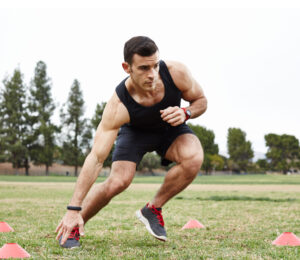Phase 3
Running, Agility and Landing
There are 3 main goals to achieve in this Phase.
- Attain excellent hopping performance (technique, distances, and endurance)
- Progress successfully through an agility program and modified gameplay.
- Regain full strength and balance.
Within Phase 3, a returning athlete will begin returning to running, agility, jumping and hopping while continuing with their Phase 2 Strength and Neuromuscular programming.
The knee should be swelling and pain free during this phase and emphasis is placed on proper technique in deceleration tasks such as landing from jumps.
Landing technique and pivoting biomechanics need to be “perfected” prior to fully returning to sport.
During this Phase, athletes can also commence change of direction and modified gameplay although, these should be completed under supervision of a Physiotherapist or Strength & Conditioning Coach.
Exercises that can be included within this training Phase can include – slalom runs, shuttle runs, ladder drills. Jumping and hopping exercises can begin with scissor jumps and single hops before progressing to box jumps and single leg landings.
With an increase in weekly loads, recovery and rest are important factors to remember during this Phase.
Phase 4
Returning to Sport
Current research suggests a minimum of 9 months before an athlete should look to return to sport. However, this should be guided by their support team.
Phase 4 of ACL Rehabilitation should be individualised to each athlete and should see the athlete returning to exercises and training activities that are usual for the athlete when not injured.
The focus should be on ensuring that the athlete is ready to return. The knee should be stable, strong and able to perform neuromuscular patterns optimally. During this Phase the athlete must be confident and mentally ready to return to sport. This confidence should be built through repetition of successful training and game play scenarios.
The athlete should continue to build their strength, balance, agility, running and landing work progressively building from restricted to unrestricted with a return to competition when they’re ready.
3 criteria that an athlete should meet are:
- Successful completion of the Melbourne Return to Sport Score
- Be confident, comfortable, and eager to return. This is measured by the ACL-RSI and IKDC
- An ACL injury prevention program has been discussed, implemented, and continued whilst the athlete is participating in sport.




